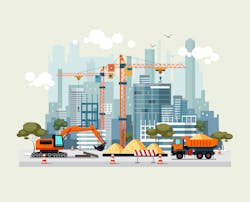The numbers are so big that the federal budget almost seems like an abstract notion. Every year there is a monthslong series of news reports about what’s proposed, argued over, cut and finally passed. It is a complex, geeky process that seems far removed from molding or extruding plastic parts.
But this year it might be worthwhile for processors and machinery makers to pay closer attention.
There is plenty for the plastics industry to like about the $1.2 trillion bipartisan infrastructure bill passed by the U.S. Senate in August, but sadly a couple items were cut that are important for plastics processors.
The U.S. House of Representatives is scheduled to vote on an infrastructure bill in late September and it is widely believed it will be approved.
New federal spending in the Senate bill amounts to $550 billion, about the same as the cost of the Interstate Highway System after adjusting for inflation.
First, the good news.
Over the next five years, traditional hard infrastructure projects related to transportation will get a $241 billion total investment, with roads and bridges receiving the largest chunk at $110 billion.
Additionally, power and water infrastructure projects as well as broadband expansion will see $185 billion in investment.
Cleaning up abandoned wells, mines and Superfund sites will see a $21 billion investment.
Core infrastructure spending on transportation, utilities and pollution cleanup are all good for the plastics industry. Huge amounts of plastic pipe, plastic drainage products, power transmission components, signs, wire and cable, rail cars and components for electric vehicles will need to be manufactured.
U.S. Senator Rob Portman (R-Ohio), the lead Republican negotiator of the bipartisan infrastructure legislation, also successfully pushed for $15 million per year to educate households and consumers about residential and community recycling programs. Collection is the weak link in the country’s recycling system and needs special attention if enough recycled plastics is to be produced to meet consumers’ growing demands.
The bill passed by the Senate amounted to $550 billion in new spending, compared with the Biden administration’s original proposal of $2.6 trillion. Here are a few items that were eliminated.
Research and development and manufacturing support was proposed to get $566 billion, the largest single item. It was eliminated. This category included investing in manufacturing and research on climate change and clean energy.
Some $387 billion proposed for housing, schools and buildings was also slashed from the original proposal. It would have gone toward building more public housing, modernizing public schools and improving federal hospitals and buildings.
Clean energy tax credits proposed at $363 billion were also eliminated.
Investment in U.S. manufacturing, construction of public facilities and clean energy are all important to manufacturing in general and the plastics industry as well.
The infrastructure bill will get massaged again in the House and some of the items eliminated by the Senate could go back into the final version. There is reason to believe an infrastructure bill will eventually get signed into law.
The most frequent argument against such a massive plan is that it could add $256 billion to the federal budget deficit over the next 10 years. But the bill’s authors, including Sen. Portman, said the new spending would be offset by a combination of savings and new revenue totaling twice that amount.
The U.S. has largely ignored its infrastructure for too many years. You could argue that has been the case since the Interstate Highway System was built 65 years ago.
The Plastics Industry Association praised the plan, particularly sections that would improve plastics recycling. The association strongly endorsed proposals to establish a recycling infrastructure within the Environmental Protection Agency (EPA) to invest in new recycling technology and increase collection rates.
It is difficult to wrap your arms around the concept of infrastructure. Fortunately, every four years the American Society of Civil Engineers (ASCE) studies critical components and grades how we are doing. Consider this: The 2021 report gave the country’s overall infrastructure a C-.
ASCE pointed out there is a water main break every 2 minutes, releasing an estimated 6 billion gallons of treated water; normal wear and tear has left 43 percent of public reads in poor or mediocre condition; an estimated 42 percent of our 617,000 bridges are at least 50 years old and more than 7 percent are structurally deficient; there are 30,000 miles of inventoried levees in the U.S. plus an estimated 10,000 whose location and condition are unknown.
The ASCE is urging its members to contact members of Congress to voice support of the infrastructure bill. That is good advice for the plastics industry as well.
We don’t want to be a C- nation when it comes to our roads, transit systems, water and electric grids. It is impossible to be an A+ manufacturing country in a global market if we are being held back by our national infrastructure.
Ron Shinn, editor
Ron Shinn | Editor
Editor Ron Shinn is a co-founder of Plastics Machinery & Manufacturing and has been covering the plastics industry for more than 35 years. He leads the editorial team, directs coverage and sets the editorial calendar. He also writes features, including the Talking Points column and On the Factory Floor, and covers recycling and sustainability for PMM and Plastics Recycling.
High-tech skills come at high price
So, you need a new ERP. Now what?






